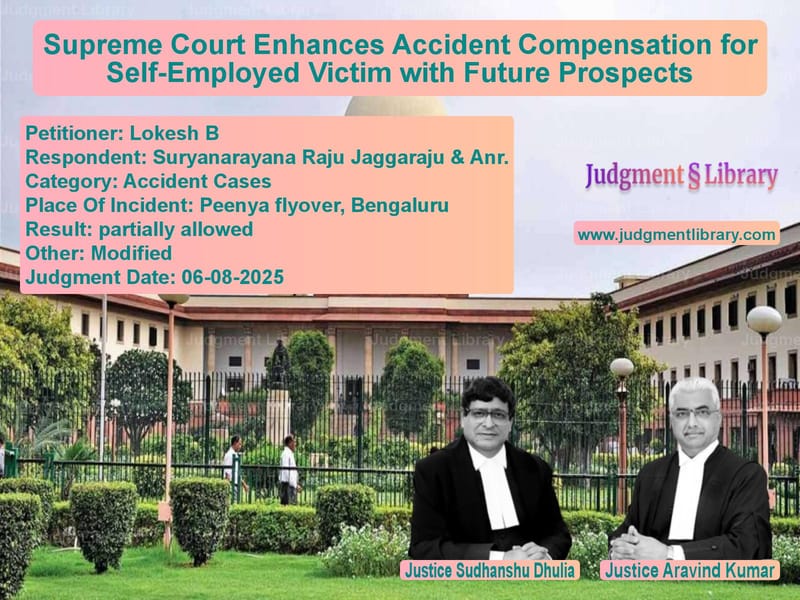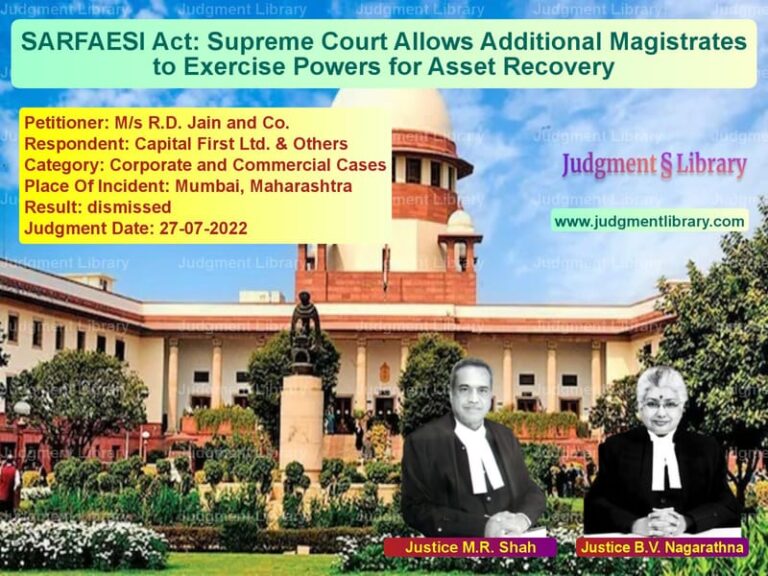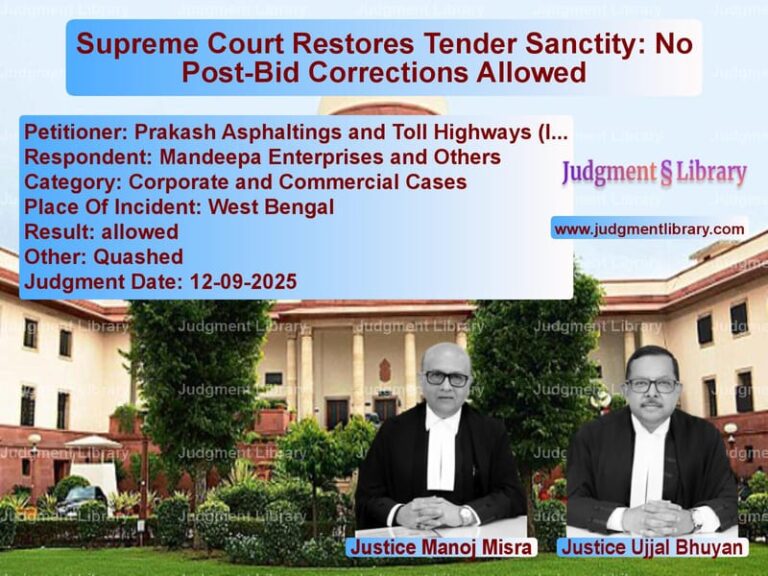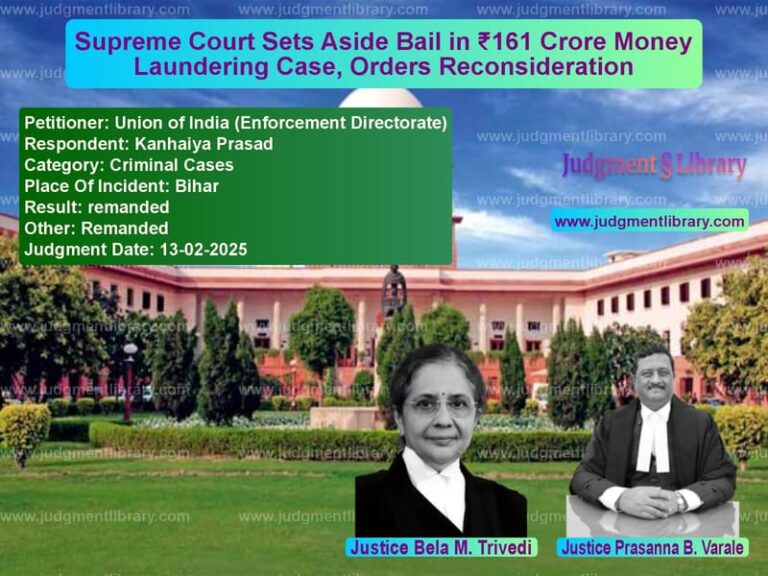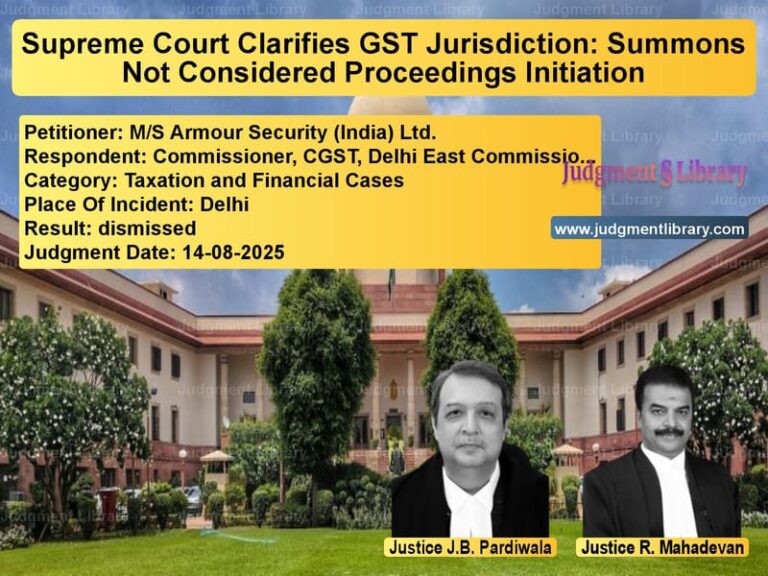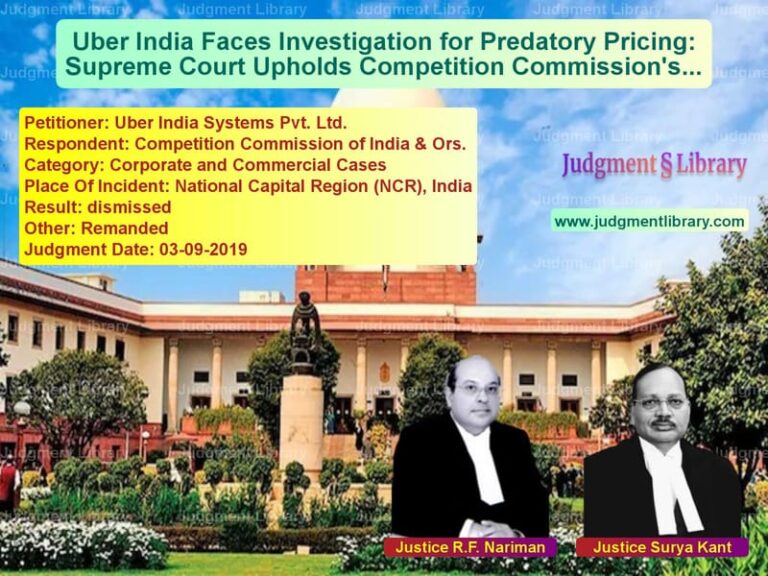Supreme Court Enhances Accident Compensation for Self-Employed Victim with Future Prospects
In a significant ruling that reinforces the rights of accident victims, particularly those who are self-employed, the Supreme Court of India recently enhanced the compensation awarded to a Bengaluru-based tailor who suffered severe injuries in a road accident. The case of Lokesh B versus Suryanarayana Raju Jaggaraju & Another brought into focus two crucial aspects of accident compensation claims: the entitlement of self-employed individuals to future prospects and the proper assessment of disability based on medical evidence.
The unfortunate incident occurred on the morning of November 19, 2016, on the Peenya flyover in Bengaluru. Lokesh B, a 38-year-old tailor driving his Omni car, collided with a lorry that was allegedly parked in the middle of the flyover without proper indicators or reflective warnings. The impact caused devastating injuries to Lokesh, including skull fractures, frontal hemorrhage, optic nerve trauma resulting in visual impairment, and bilateral wrist fractures. His medical journey involved treatment at Premier Sanjeevini Hospital followed by an extended hospitalization at Sparsh Hospital from November 19 to December 5, 2016.
The legal battle for compensation began when Lokesh approached the Motor Accident Claims Tribunal in Bengaluru. The Tribunal determined his monthly income at ₹8,000, applied a multiplier of 15 based on his age of 38 years, assessed his disability at 35%, and added 50% of his income towards loss of future prospects. The total compensation awarded was ₹17,01,140, which was reduced to ₹13,60,912 after applying a 20% deduction for contributory negligence. This finding of contributory negligence meant the Tribunal believed Lokesh shared some responsibility for the accident.
Unsatisfied with this award, both parties appealed to the High Court of Karnataka. The insurance company challenged the compensation amount, while Lokesh sought enhancement. The High Court revised his monthly income to ₹9,500 but made a crucial change – it completely omitted future prospects from the calculation. The Court retained the disability assessment at 35% and awarded a total compensation of ₹16,74,640, which reduced to ₹13,44,712 after the 20% contributory negligence deduction. This decision prompted Lokesh to approach the Supreme Court, seeking proper compensation that reflected his actual losses and future earning potential.
Before the Supreme Court, Lokesh’s counsel made a strategic concession, acknowledging that the finding of 20% contributory negligence would not be challenged. This allowed the Court to focus on the core issues: whether the High Court erred in excluding future prospects and whether it properly assessed the disability percentage. The Supreme Court bench comprising Justices Sudhanshu Dhulia and Aravind Kumar found merit in both of Lokesh’s contentions.
The Court first addressed the issue of future prospects for self-employed individuals. It referenced two landmark judgments that had established this principle. In Santosh Devi v. National Insurance Company Limited and Others, the Supreme Court had extended future prospects to self-employed persons, recognizing that their earnings naturally increase over time due to experience, skill development, and inflation. This principle was further reinforced in National Insurance Company Limited v. Pranay Sethi and Others, where the Court categorically stated that self-employed individuals are entitled to future prospects.
The Supreme Court explicitly stated: “Though the appellant is self-employed, the law is now well settled that such claimants are entitled to future prospects.” Based on this established legal position, the Court added 40% towards future prospects, significantly enhancing the compensation calculation. This recognition that self-employed individuals experience income growth similar to salaried employees represents an important evolution in compensation jurisprudence, acknowledging the economic realities faced by entrepreneurs and small business owners.
The second major issue concerned the proper assessment of disability. The evidence presented included testimony from Dr. Prathibha Sharan, a Neuropsychologist from NIMHANS, who had conducted comprehensive neuro-behavioral and cognitive assessments using the validated NIMHANS Battery. Her assessment revealed a disability of 41.77%, which neither the Tribunal nor the High Court had properly considered or rebutted. The Supreme Court noted that “the evidence of PW3 Dr. Prathibha Sharan… was neither rebutted nor doubted. There was no contrary medical evidence. The Tribunal and High Court adopted 35% without any reasoning.”
This observation highlights a common problem in accident compensation cases – courts sometimes arbitrarily reduce disability percentages without proper justification or contrary medical evidence. The Supreme Court corrected this by accepting the scientifically assessed disability figure of 41.77%, emphasizing the importance of relying on expert medical testimony rather than arbitrary assessments.
With these corrections, the Supreme Court recalculated the compensation. Starting with the accepted monthly income of ₹9,500, the Court added 40% for future prospects, bringing the figure to ₹13,300 per month. The annual income became ₹1,59,600, which when multiplied by the multiplier of 15 and the disability percentage of 41.77%, resulted in loss of future earnings amounting to ₹9,99,974. This represented a substantial increase from previous calculations.
The Court maintained other compensation heads awarded by the High Court, including medical expenses of ₹8,18,140, pain and suffering of ₹75,000, attendant and conveyance charges of ₹20,000, loss of income during treatment of ₹38,000, and loss of amenities of ₹1,25,000. The total compensation came to ₹20,76,114, which after the 20% contributory negligence deduction resulted in a net payable amount of ₹16,60,891.
The Supreme Court directed that this enhanced compensation carry interest at 6% per annum from the date of the original claim petition until payment or deposit. The insurance company, M/s Shriram General Insurance Co. Ltd., was given six weeks to deposit the enhanced amount after deducting any sums already paid. The Court also took the unusual step of directing the Registry to forward copies of the judgment to both the Motor Accident Claims Tribunal in Bengaluru and the Registrar General of the High Court of Karnataka, ensuring proper implementation of its directions.
This judgment serves as an important reminder of several key principles in accident compensation law. First, it reaffirms that self-employed individuals are entitled to future prospects, recognizing that entrepreneurship and skilled trades also experience income growth over time. Second, it emphasizes that disability assessments must be based on proper medical evidence rather than arbitrary judgments. Third, it demonstrates the Supreme Court’s role in ensuring that compensation truly reflects the actual losses and future challenges faced by accident victims.
The case also illustrates the practical realities of India’s legal system for accident victims. Lokesh’s accident occurred in 2016, and it took nearly nine years for him to receive final justice through the Supreme Court in 2025. This timeline highlights the importance of getting compensation calculations right at the initial stages, as the appeals process can be lengthy and burdensome for victims already struggling with their injuries.
For thousands of self-employed individuals across India – from tailors and artisans to shopkeepers and service providers – this judgment provides reassurance that their future earning potential will be properly considered in compensation claims. It acknowledges that being self-employed doesn’t mean one’s income remains stagnant, and that accident compensation must account for the natural progression of skills, reputation, and earning capacity that comes with experience.
The Supreme Court’s meticulous approach in this case, from properly evaluating medical evidence to applying established legal principles consistently, sets a valuable precedent for lower courts handling similar cases. It reinforces that compensation law must evolve to reflect contemporary economic realities and that justice requires a comprehensive understanding of how accidents impact victims’ lives beyond immediate medical expenses.
Petitioner Name: Lokesh B.Respondent Name: Suryanarayana Raju Jaggaraju & Anr..Judgment By: Justice Sudhanshu Dhulia, Justice Aravind Kumar.Place Of Incident: Peenya flyover, Bengaluru.Judgment Date: 06-08-2025.Result: partially allowed.
Don’t miss out on the full details! Download the complete judgment in PDF format below and gain valuable insights instantly!
Download Judgment: lokesh-b-vs-suryanarayana-raju-j-supreme-court-of-india-judgment-dated-06-08-2025.pdf
Directly Download Judgment: Directly download this Judgment
See all petitions in Road Accident Cases
See all petitions in Compensation Disputes
See all petitions in Motor Vehicle Act
See all petitions in Negligence Claims
See all petitions in Judgment by Sudhanshu Dhulia
See all petitions in Judgment by Aravind Kumar
See all petitions in partially allowed
See all petitions in Modified
See all petitions in supreme court of India judgments August 2025
See all petitions in 2025 judgments
See all posts in Accident Cases Category
See all allowed petitions in Accident Cases Category
See all Dismissed petitions in Accident Cases Category
See all partially allowed petitions in Accident Cases Category

